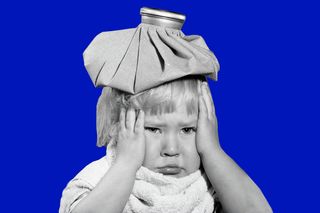
The Amount of Pain Kids Expect is the Amount of Pain Kids Feel
They say honesty is the best policy, but maybe not in this case.

“It won’t hurt at all, you’ll just feel a tiny pinch.”
Psyching kids out about how something may hurt might not be in their best interests. In a latest study, researchers have found that kids who perceive something to be painful will inadvertently find the process more painful than it actually might be. The research published in the journal Psychosomatic Medicine explores how expectation influences how a child experiences pain.
“We know that expectation affects pain experience in adults; we don’t know whether this is also true for children,” says psychologist Kaline Michalska from University of California – Riverside, who discusses children’s reaction to distress in Kids Interaction and Neuro Development Lab.
Pediatrician and faculty at UCR School of Medicine Dr. Adwoa Osei explains, that in her experience, preparing children for vaccines beforehand is usually unhelpful. For instance, penicillin shot is the most painful, as the consistency of the medicine is relatively much thicker than any other.
“If I don’t say anything before, they might limp a little leaving the office,” says Osei. “But if I tell them it’s going to be painful, afterward they say, ‘I can’t walk!’ or ‘You have to carry me out of the room.'”
In the study, researchers applied thermal heat, asking the participants to rate the level of pain they experienced as either low, medium or high – high being equivalent to very warm tap water. In actuality, the subjects experienced only one level of heat – the level they rated as medium. However the participants experienced three different tonal cues just before heat was applied. One tone signified low, one medium and one high.
This means that even though the participants may be experiencing only one level of pain — medium, they might here the tone for high level of pain. Using 21 healthy children, 27 children with an anxiety disorder, and 25 adults, these tests were carried out.
The research team had expected to find the strongest correlations of expectation-experience among the group of anxious children, followed by the healthy children group and then adults. Taking into account that in past experiences through the years, children have always been found much more gullible to their social and technological surroundings. But in carrying out these tests, the team found that all three groups of people experienced similar relationships between their perception of expectation and experience.
However, Michalska adds that her efforts to reassure children may have impacted the results to some degree, claiming that it is an ethical paradox.
“We took great care to reassure children and make them feel comfortable. There were always two experimenters in the room with them and a nurse who saw them before and after to ensure they were OK,” explains Michalska. “We did not take as great a precaution with adults.”
This ethical dilemma is the reason why this is one of the forerunning research of its kind. However, she asserts that it does not disprove the fact that pain expectation affects pain experience.
“What we learn is that both healthy and anxious children’s experience of pain is influenced by what they are told about it. If we tell them they will experience a lot of pain – or they tell themselves this – they will actually experience more pain and greater negative emotions as a consequence,” she concludes.
The trick is to not hype up painful experiences for kids, and discourage them from building it up in their heads. Next time, distract them by providing a comparison to a much less painful experience.
Angelina Shah is a staff writer with The Swaddle. In her previous life she was a copywriter in advertising. She has a penchant for reading, singing, travelling and being obsessed with superheroes.
Related


Are You Remembering Your Childhood Correctly?
